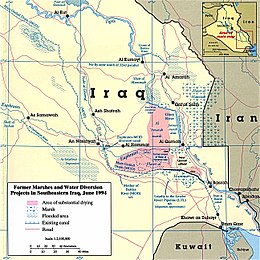Central Marshes
| UNESCO World Heritage Site | |
|---|---|
 1994 Map of The Mesopotamian Marshes with draining features | |
| Location | Iraq |
| Part of | Ahwar of Southern Iraq |
| Criteria | Mixed: (iii)(v)(ix)(x) |
| Reference | 1481-002 |
| Inscription | 2016 (40th Session) |
| Area | 62,435 ha (241.06 sq mi) |
| Buffer zone | 83,958 ha (324.16 sq mi) |
| Coordinates | 31°5′7″N 47°3′15″E / 31.08528°N 47.05417°E |
| Designated | 7 April 2014 |
| Reference no. | 2241[1] |
The Central or Qurna Marshes are a large complex of
1991 uprisings in Iraq
and have in recent years been reflooded.
Characteristics
The Central Marshes stretched between
syn. Erythronesokia bunnii), which had only been described from specimens obtained in the Central Marshes, is extinct.[6]
The area was formerly populated by the
buffalo
on the natural vegetation and carried out cultivation of rice.
Draining
By the early 1980s, it was evident that irrigation projects were already affecting water levels in the marshes.Qalat Saleh.[2] By the late 1990s, the Central Marsh had become completely desiccated, suffering the most severe damage of the three main areas of wetland. By 2000, United Nations Environment Programme estimated that 90% of the marshlands had disappeared.
Reflooding
Following the
2003 U.S. invasion of Iraq, embankments and drainage works were broken open, and the marshes began to reflood. The Central Marshes showed little recovery through 2003, but by early 2004 a patchwork of lakes had appeared in northern areas; there was flooding in southern areas which had previously been dry since the early 1990s.[8] There has been some corresponding recolonisation by the natural marsh vegetation since that time, and return of some species of fish and birds, although recovery of the Central Marshes has been much slower compared to the Huwaizah and Hammar Marshes; the most severely damaged sections of the wetlands have yet to show any signs of regeneration.[9] Bunn's short-tailed bandicoot rat is suspected to have become extinct.[citation needed
]
References
- ^ "Central Marshes". Ramsar Sites Information Service. Retrieved 25 April 2018.
- ^ a b The Physical Characteristics of the Mesopotamian Marshlands, edenagain.org
- ^ a b Central Marshes, birdlife.org
- ^ Abed, J.M. (2007). Status of Water Birds in Restored Southern Iraqi Marshes. Marsh Bulletin 2(1): 64-79.
- ^ Al-Sheikhly, O.F.; and Nader, I.A. (2013). The Status of the Iraq Smooth-coated Otter Lutrogale perspicillata maxwelli Hayman 1956 and Eurasian Otter Lutra lutra Linnaeus 1758 in Iraq. IUCN Otter Spec. Group Bull. 30(1).
- ISBN 2-8317-0270-4.
- ^ Spencer, M. The Marsh Arabs Revisited Archived 2009-01-07 at the Wayback Machine Saudi Aramco World, April 1982
- ^ Iraq Marshlands Restoration Program[permanent dead link], iraqmarshes.org, p.6
- UNHCR, 2006, p.44

